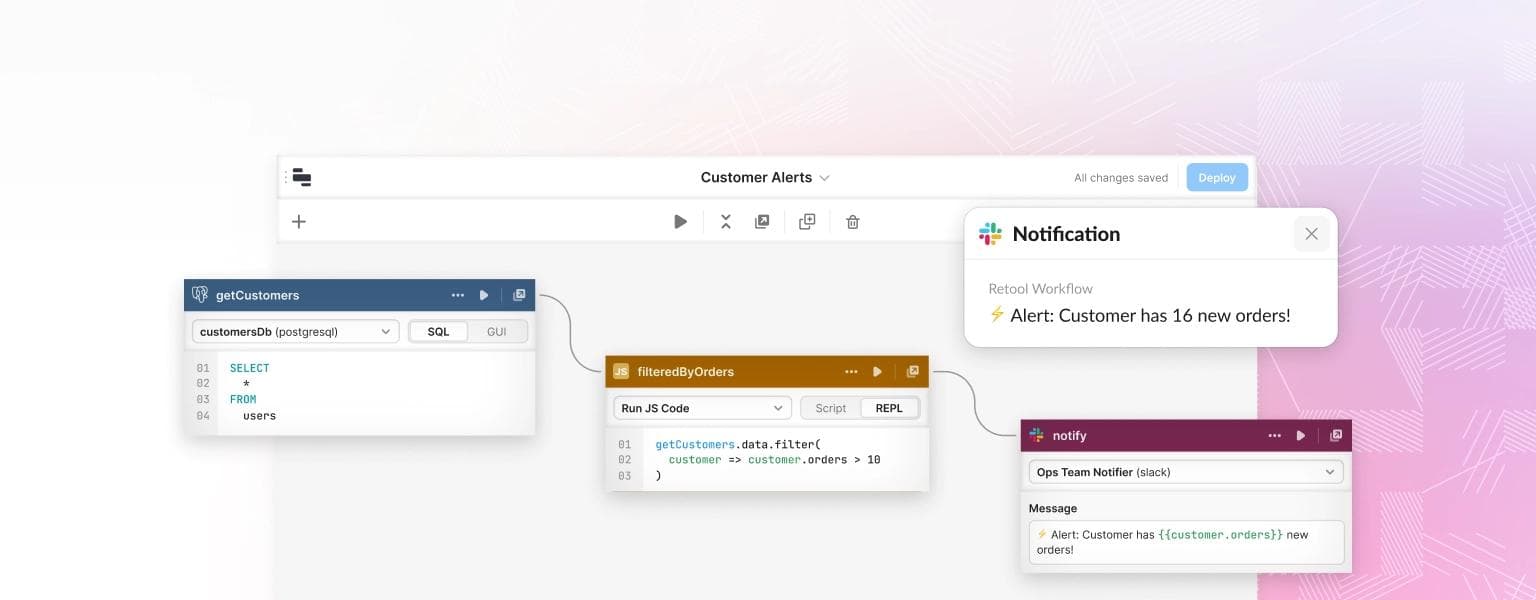We started Retool to help developers build internal tools faster—starting with a faster way to build custom UIs. But since we launched Retool, the most persistent feature request has been: can I build backends or automate logic in Retool as well? Customers have even hacked Retool to do this (we've seen quite a few customers attempt to script Retool apps via PhantomJS!).
That’s why today, we’re launching Retool Workflows: a fast way for developers to build automated processes—like cron jobs, custom alerts, and ETL tasks—and trigger them on event-based or recurring schedules. Start building for free →
Our customers have often told us they can’t find a fast way to automate processes for their business. Things like responding to customer behavior in real time or moving data across tools still feel like a burden.
Code is the best way to program a computer, since it gives you complete flexibility over the outcome. That’s why we don’t believe in low/no-code tools: they get you to 50% of what you want quickly, but you generally aren’t able to customize the last 50%, and have to build from scratch to get to an ideal outcome.
But coding cron jobs from scratch can be heavy. There’s a lot of overhead—if your cron job stops running, good luck trying to figure out why!—and most developers end up spending most of their time on the boilerplate: spinning up servers, building observability for when cron jobs fail, connecting to backends (especially something that requires OAuth 2.0!), etc. All of this instead of actually focusing on the core business logic that drives their business forward.
Retool Workflows is the first developer-focused workflow automation tool. We are code-first, but allow you to stop worrying about the boilerplate. It just works out the box—including things like monitoring, error handling, and data access and integrations).
Workflows are composed of a series of blocks––interconnected resource queries or Javascript––that help you visualize your logic on an infinite canvas. Within each block, you can focus on only writing the custom business logic unique to the automation you’re building.
Here’s how it works:
- Define your trigger: Identify how you want your workflow to run—we support either a cron schedule or triggering with a webhook.
- Pull in your data: Workflows integrates with any database or API. Just grab a block, query your resources (APIs, databases, etc.), and immediately preview the data your workflow will use.
- Write your logic: Chain together blocks to form sequences of actions. Write code to transform and join data, import libraries (like MomentJS), and write complex conditionals for complete control of your workflow logic. Or, use our pre-built logic blocks, like Loop, Branch, and Filter, to cut down on boilerplate for common code logic.
- Run your process: Deploy your workflow to begin sending notifications, transforming data, escalating incidents, assigning tasks, and more. If you can write it in JavaScript, you can run it on Workflows.
We've packed Retool Workflows with features that help developers write and deploy powerful automations faster, including:
- Native integrations: Directly authenticate to, and call, any resource—internal APIs, databases, or third-party integrations like Slack or Salesforce––without having to configure OAuth flows or setting up client libraries.
- Functions: Query resources directly inline with code. And because it’s code, it’s fully reusable, you can share it across different blocks across Workflows.
- Debugging and environments: Test and debug by running workflow steps incrementally, just as you would with a step-through debugger in an IDE. Test with mock data housed in different environments for staging, QA, and production, and more.
- Logging and monitoring: Global error handlers slot directly into your software development practices—send logs to Datadog, get alerts in Slack, or set escalations in PagerDuty to get notified immediately if anything in your workflow goes wrong.
- Security and access controls: Retool Workflows provides granular access controls, credential management, and audit logs all out of the box.
- Better together: Workflows brings your backend processes into the powerful Retool platform, enabling you to reuse data connections and security configuration with no additional infrastructure to maintain.
We’re just getting started and have several more features coming soon: integrating automation and frontend apps built in Retool, deploying Retool Workflows self-hosted in your VPC, Python support, importing npm libraries, source control, and more.
Companies like Motive, Cameo, RE/MAX, Best Western Hotels, and The Modern Milkman have used Workflows to automate all kinds of manual tasks.
The Modern Milkman, a UK-based delivery service, built over 100 automations in Workflows—from connecting support tickets in Jira to their custom CRM, to notifying customers when orders are delivered, to creating real-time maps for their field sales team.

Instead of combing through multiple dashboards, Joel McLean, Director of Product Growth at RE/MAX, built a single workflow to aggregate data across their warehouse and internal services to provide a weekly metrics report across all of their product data for their leadership team. He adds, “With Retool Workflows, my team can focus only on writing the logic unique to our business.”
And at Retool, we ourselves use Workflows to monitor our Postgres databases for dead tuples, set up Slack groups for on-call engineers, and notify our account teams about high-growth customers.
Retool Workflows is now available in beta for all cloud-hosted Retool instances. Every Retool plan comes with 1 GB of workflow data per month included free, so you can focus on the data you’re moving rather than worrying about hitting “step” or “task” limits. We want all developers to use Retool Workflows, and around 90% of our early access users have been able to run their production Workflows within the 1 GB limit for free.
To get started, check out our docs and step-by-step tutorials, or visit the community forum to see a few of the hundreds of workflows Retool users already have running. And as you’re building, please send any feedback or feature requests to me at jamie@retool.com––we hope you’ll love building with Retool Workflows!
Reader



